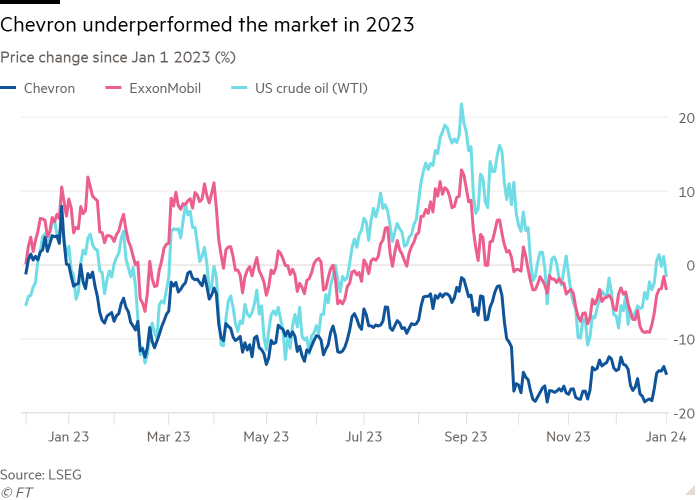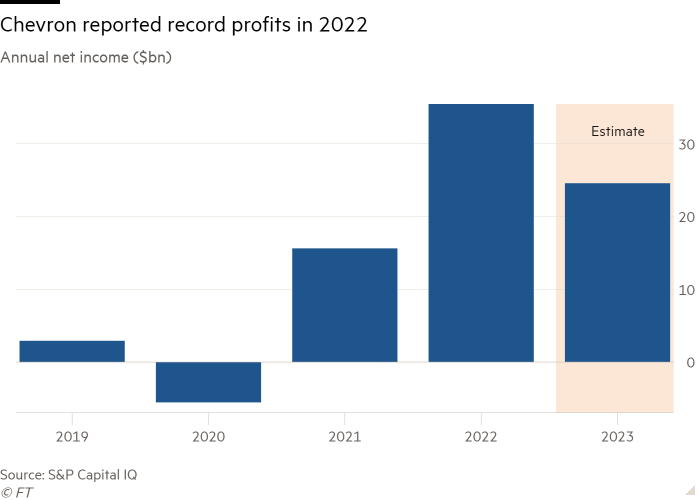
A year ago Chevron was flying high.
Chief executive Mike Wirth lauded “an outstanding year” as the second most valuable US oil company reported its best-ever annual profit haul of $36bn, allowing it to shower enormous returns on shareholders.
But 12 months on, there are growing signs that Chevron — which reports its 2023 full-year earnings on Friday — has entered a rocky patch.
Key oil operations in Kazakhstan and the US have disappointed investors and the company has been slammed for a lacklustre climate strategy that some analysts have dubbed the worst among its peers.
The climate fallout has been particularly pronounced in the California-headquartered company’s own state, where a rift with lawmakers is set to take a chunk out of its earnings.
Chevron’s woes have put the glare of the spotlight on a company — valued at about $277bn — that has long avoided the brunt of anti-oil criticism hurled at its much larger rival, ExxonMobil.
“We think there is risk heading into the Q4 results and current consensus estimates may be too high,” said Paul Cheng, analyst at Scotiabank.
Last year was a bumpy one for the oil major. Chevron’s shares fell 17 per cent, compared to a 9 per cent drop for Exxon, which is also due to release results on Friday.
Warren Buffett’s Berkshire Hathaway sold off some of its Chevron holdings in 2023. Two investment banks, Scotiabank and Cowen, downgraded the company’s stock last month.

This followed a period of bumper returns after Wirth, who took the helm in 2018, streamlined the group to focus on a smaller number of high-performing oil and gas assets, shunned the diversification into renewables pursued by European majors and doubled down on fossil fuels.
That left Chevron well positioned when oil prices jumped following Russia’s full-scale invasion of Ukraine in 2022. Record profits enabled it to announce a mammoth $75bn share buy-back plan last year and boosted its dividend payout for the 36th year in succession.
But as oil prices moderated last year, so too did profits across the industry. Analysts estimate Chevron will bring in net income of about $25bn for 2023, according to S&P Global Market Intelligence.
Analysts connect Chevron’s share price underperformance to issues at two critical locations. One is the $45bn expansion of the Tengiz oilfield in Kazakhstan, which has faced repeated delays and cost overruns. The other is the Permian Basin — the vast oilfield that stretches across west Texas and New Mexico — where production increases have slowed.
“When those assets do well so does the stock,” said Jason Gabelman, analyst at TD Cowen. “But when these assets don’t then the company has to answer a lot of questions from investors.”
Gabelman said investors were hesitant to trust the company’s latest guidance that the 260,000 barrel-a-day Kazakhstan expansion project — operated by Tengizchevroil in which Chevron has a 50 per cent stake — would start up in the first half of next year “given the hiccups that they’ve had there”. Chevron declined to comment for this article, citing a quiet period before its earnings release.
In the Permian, where Chevron is one of the biggest producers, it has been hit by low productivity at older wells and constraints on reinjecting wastewater from fracking, requiring it to spend more on infrastructure while dialling back production.
Questions have also been raised about Chevron’s planned $53bn acquisition of Hess — its biggest ever — bringing with it a stake in the biggest oil discovery in recent years off the coast of Guyana.
“Due to the uncertainty over future oil demand in the years ahead with the energy transition, investors increasingly value the flexibility that short-cycle shale provides in terms of quick returns when compared to Guyana’s deepwater offshore project that will require a lot of investment before payback,” said Andrew Gillick, an analyst at Enverus.
But after a disappointing year, some analysts believe Chevron has ironed out its issues. “Going forward, we are increasingly comfortable with US production targets, timing [and] costs at Tengiz and lack of impact from [disruptions to the Guyana project],” said Lloyd Byrne, an analyst at Jefferies, who upgraded the stock earlier this month.
Over the past two years investors have rewarded Chevron’s decision to stick with its core fossil fuel business, rather than follow European rivals BP and Shell in investing heavily in technologies such as wind and solar. But this strategy has made it a target for climate campaigners, progressive politicians and regulators.
On emissions, Chevron is increasingly seen as having fallen to the back of the pack among its peers.
It was the only western oil major not to sign up to a charter at the COP28 climate conference in Dubai that commits companies to curbing emissions of carbon and methane from their operations. John Kerry, the US climate envoy, singled the company out. Asked at COP28 what more Chevron could be doing on climate, he responded: “everything”.
Chevron is also the only big player not to sign up to the UN-led Oil and Gas Methane Partnership, which requires greater transparency on emissions of the potent greenhouse gas, after Exxon signed up in November.

“I would never have thought that I would see the time when Chevron would lag Exxon in terms of addressing climate change, but that really does seem to be the case at the moment,” said Andrew Logan, senior director of the oil and gas programme at sustainability non-profit Ceres.
After shareholders voted in favour of greater climate action at Chevron in 2021, the company introduced an “aspiration” to reach net zero emissions in its own operations by 2050 and a target to cut the intensity of its emissions across the board — including from its products, known as scope 3 — by more than 5 per cent between 2016 and 2028. Exxon has not set any scope 3 targets.
Nowhere is the climate pressure higher than in California. Last month Chevron warned that “continuing regulatory challenges” in that state would contribute to a non-cash charge of $3.5bn-$4bn in the fourth quarter.
The disclosures relate to its oil production and refining operations there, where the company can trace its history back more than 140 years.
Wirth told the Financial Times in an interview last year that Chevron had “never deceived anybody” and defended its record on tackling greenhouse gas emissions.
But when he faces investors on Friday, his immediate challenge will be to convince them that he can overcome the operational challenges in the Permian and Kazakhstan, while delivering on its big bet on Guyana.
Climate Capital

Where climate change meets business, markets and politics. Explore the FT’s coverage here.
Are you curious about the FT’s environmental sustainability commitments? Find out more about our science-based targets here
